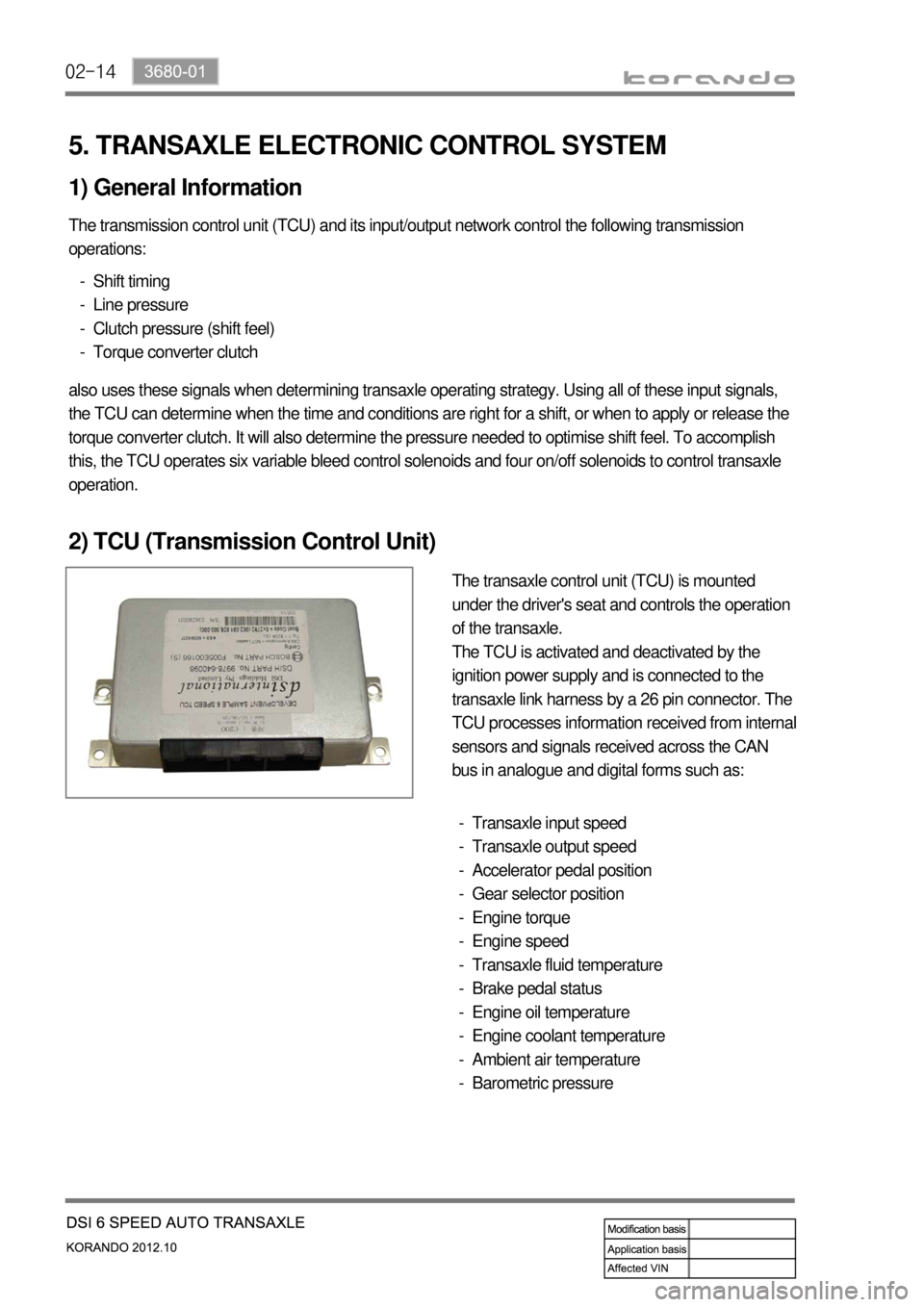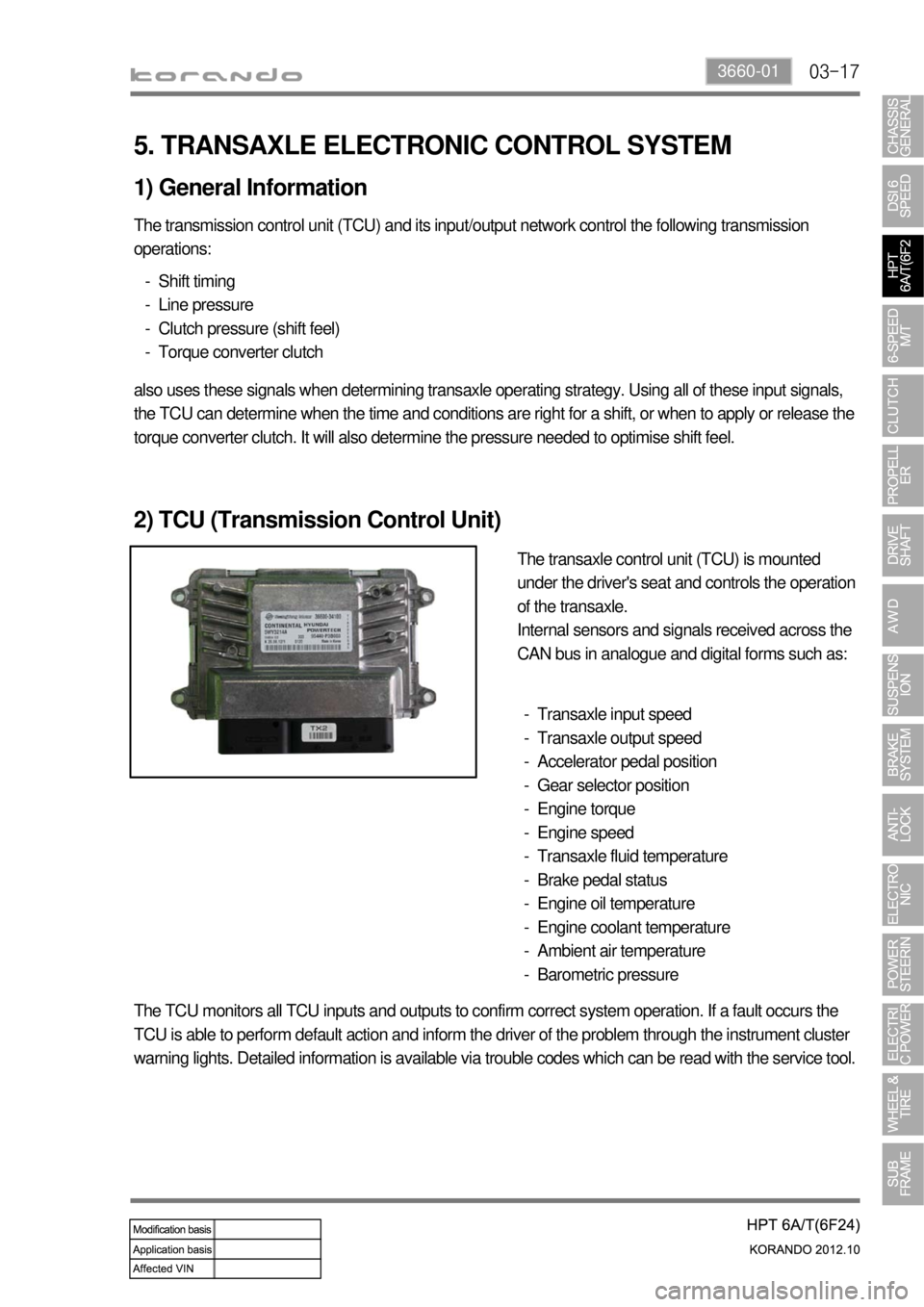Page 485 of 1082

15-20
(4) Cooling Fan and A/C Compressor Control
Conditions for cooling fan ▶
The cooling fan module controls the cooling fan relay, high speed relay and low speed relay.
The cooling fan is controlled by the series and parallel circuits
A/C
switchCooling
fanCoolant temperatureRefrigerant
pressureA/C
compressor
OFFOFFCoolant temp.<90℃-
LO90℃≤Coolant temp.<105℃-
HI105℃≤Coolant temp.-
ONLO
Coolant temp.<105℃Refrigerant
pressure<18 bar
ON
HI18 bar≤Refrigerant
pressure
HI105℃≤Coolant temp.<115℃-
HI115℃≤Coolant temp.- OFF (cut)
A/C compressor OFF conditions ▶
Coolant temperature: over 118℃
Approx. 4 seconds after starting the engine
When abrupt acceleration
Refrigerant pressure:
* OFF below 2.0 kg/㎠, then ON over 2.4 kg/㎠
* OFF over 32 kg/㎠, then ON below 26.0 kg/㎠ -
-
-
-
Output voltage according to refrigerant pressure ▶
The output voltage from refrigerant pressure sensor is 1.7 V to 3.5 V when the refrigerant pressure is 10
to 24 kgf/㎠ with A/C "ON".
Cooling fan control by ATF temperature ▶
ATF temperature Cooling fan speed Remark
Over 110˚CHI -
Page 494 of 1082
01-6
2. SPECIFICATION
DescriptionDiesel 2.0 Engine
(D20DTF(Low CO2))
General Overall length (mm) 4,410 (4,500: with trailer hitch)
Overall width (mm) 1,830
Overall height (mm) 1,675
Gross vehicle
weight (kg)M/T 4WD : 2,065(2,110)
2WD : 1,905(1,920)
Curb vehicle
weight (kg)M/T 4WD : 1,740(1,785)
2WD : 1,580(1,595)
Fuel Diesel
Fuel tank capacity (ℓ)57
Engine Engine D20DTF
Number of cylinders/ Compression ratio 4 / 16.5:1
Total displacement (cc) 1,998
Camshaft arrangement DOHC
Max. power M/T 149 ps / 4,000 rpm
Max. torque 360 Nm / 1,500~2,800 RPM
Idle speed750 ± 20 rpm
Cooling system Water-cooled / forced circulation
Coolant capacity (ℓ)8.5
Lubrication type Gear pump, forced circulation
Max. oil capacity (ℓ)6.0
Turbocharger and cooling type Turbocharger, water-cooled
Page 496 of 1082
01-8
3. RECOMMENDED FLUIDS AND LUBRICANTS
Descriptions Capacity Specifications
Engine OilDiesel 2.0≒ 6.0ℓ Quality class: Ssangyong genuine engine oil
(Total Quartz INEO ECS 5W 30, SK ZIC SY
5W 30 or oil Approved by MB 229.51 SAE 5W30)
Engine Coolant Diesel 2.0≒ 8.5ℓ Ssangyong genuine coolant
Anti-Freeze: SYC-1025
Manual Transaxle
Fluid6-speed≒ 1.6ℓ Ssangyong genuine oil (HD MTF 75W/85
(SHELL) or HK MTF 75W/85(SK))
Transfer Case Fluid
4WD ≒ 0.58ℓ Ssangyong genuine oil
(IDEMITSU LW 80W/90)
Rear Axle Oil 4WD ≒ 0.7ℓ Ssangyong genuine oil
(SAE 80W/90, API GL-5)
Brake / Clutch Fluid As required Ssangyong genuine oil (DOT4)
Power Steering Fluid≒ 1.0ℓ Ssangyong genuine oil (ATF DEXRON II)
* TOTAL FLUIDE DA (Extreme cold condition
only)
Use only Ssangyong genuine fluids. Use of non-recommended products could cause damage to
the unit
Keep the specified capacity and service interval. -
-
Page 731 of 1082

06-20
Temperature dial
In full AUTO mode, the FATC receives various signals
such as the indoor temperature, ambient temperature,
engine coolant temperature, sunlight, from different
sensors to control the A/C compressor, mode door, intake
actuator assembly, air mix door, blower motors, etc. to
keep indoor environments fresh.
Fan speed dial
In full AUTO mode, the blower
motor is controlled
automatically according to the
set temperature. The blower
motor speed can also be
controlled manually.Mode dial
You can choose a desired
mode from the 5 modes by
turning the mode as required.
The dial indicator for the
selected mode comes on to
inform the operator.
Air source mode switch
When you press this switch,
recirculation indicator comes on and
the system is changed into the
recirculation mode. (However, under
defroster
mode or defroster/floor mode, it stays
in the fresh air mode.)
A/C switch
When pressing this switch, the
air conditioner operates in
manual mode and A/C ON
indicator comes on.
The A/C starts automatically
when the defroster mode is
selected.
Page 834 of 1082

01-24
4) Basic Inspection
(1) Horn operation
Listen for the horn sound when pressing the horn pad on the steering wheel. -
(2) Brake operation
Check if there is any abnormal noise, unusually long braking distance, or uneven braking force. If the
brake warning lamp does not go out even after starting the engien or are flashing during driving,
have the brake system checked immediately.
Check the brake pipes and hoses for connection, oil leak, crack or interference after changing the
position of tires. When replacing the tires, check the brake disc for surface condition and wear.
Check the parking brake cable and brake operation. Shorten the checking interval if the parking
brake is used frequently. -
-
-
(3) Exhaust system
Be aware to any changes in sound or smell from the exhaust system. These may be caused by leak or
overheat. Have the exhaust system checked and repaired immediately.
Inspect the exhaust system including catalytic converter. Inspect all the components and body frame
near the exhaust system. -
-
(4) Tires
Unusual vibration of the steering wheel and seats or pulling to one side on the straight and level roads
may indicates the uneven tire inflation pressure or poor wheel balance. -
(5) Steering and suspension system
Inspect the front and rear suspension and the steering system for damage, looseness or missing
parts, signs of wear or lack of lubrication. Inspect the power steering line and the hoses for
connection, leak, crack and chafing. Inspect the drive axle boot and seals for damage, tear or leak.
Replace or repair the system if necessary. -
(6) Engine oil
Check the oil level when the engine is still warm and add the specified engine oil if necessary. -
(7) Coolant
Check the coolant level in the coolant reservoir, coolant conditions (contamination, foreign material),
and hoses for damage and leak. Replace or add the Ssangyong genuine coolant, if needed. -
(8) Engine drive belt
Check all drive belts on the engine for wear, crack and looseness. Retighten or replace the belt, if
needed. -
Page 848 of 1082

02-14
5. TRANSAXLE ELECTRONIC CONTROL SYSTEM
1) General Information
The transmission control unit (TCU) and its input/output network control the following transmission
operations:
Shift timing
Line pressure
Clutch pressure (shift feel)
Torque converter clutch -
-
-
-
also uses these signals when determining transaxle operating strategy. Using all of these input signals,
the TCU can determine when the time and conditions are right for a shift, or when to apply or release the
torque converter clutch. It will also determine the pressure needed to optimise shift feel. To accomplish
this, the TCU operates six variable bleed control solenoids and four on/off solenoids to control transaxle
operation.
2) TCU (Transmission Control Unit)
The transaxle control unit (TCU) is mounted
under the driver's seat and controls the operation
of the transaxle.
The TCU is activated and deactivated by the
ignition power supply and is connected to the
transaxle link harness by a 26 pin connector. The
TCU processes information received from internal
sensors and signals received across the CAN
bus in analogue and digital forms such as:
Transaxle input speed
Transaxle output speed
Accelerator pedal position
Gear selector position
Engine torque
Engine speed
Transaxle fluid temperature
Brake pedal status
Engine oil temperature
Engine coolant temperature
Ambient air temperature
Barometric pressure -
-
-
-
-
-
-
-
-
-
-
-
Page 877 of 1082

03-173660-01
5. TRANSAXLE ELECTRONIC CONTROL SYSTEM
1) General Information
The transmission control unit (TCU) and its input/output network control the following transmission
operations:
Shift timing
Line pressure
Clutch pressure (shift feel)
Torque converter clutch -
-
-
-
also uses these signals when determining transaxle operating strategy. Using all of these input signals,
the TCU can determine when the time and conditions are right for a shift, or when to apply or release the
torque converter clutch. It will also determine the pressure needed to optimise shift feel.
2) TCU (Transmission Control Unit)
The transaxle control unit (TCU) is mounted
under the driver's seat and controls the operation
of the transaxle.
Internal sensors and signals received across the
CAN bus in analogue and digital forms such as:
Transaxle input speed
Transaxle output speed
Accelerator pedal position
Gear selector position
Engine torque
Engine speed
Transaxle fluid temperature
Brake pedal status
Engine oil temperature
Engine coolant temperature
Ambient air temperature
Barometric pressure -
-
-
-
-
-
-
-
-
-
-
-
The TCU monitors all TCU inputs and outputs to confirm correct system operation. If a fault occurs the
TCU is able to perform default action and inform the driver of the problem through the instrument cluster
warning lights. Detailed information is available via trouble codes which can be read with the service tool.